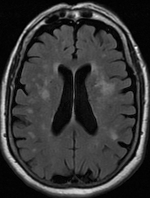
Photo from wikipedia
Executive dysfunction affects 40% of stroke patients, but is poorly predicted by characteristics of the stroke itself. Stroke typically occurs on a background of cerebrovascular burden, which impacts cognition and… Click to show full abstract
Executive dysfunction affects 40% of stroke patients, but is poorly predicted by characteristics of the stroke itself. Stroke typically occurs on a background of cerebrovascular burden, which impacts cognition and brain network structural integrity. We used structural equation modelling to investigate whether measures of white matter microstructural integrity (fractional anisotropy and mean diffusivity) and cerebrovascular risk factors better explain executive dysfunction than markers of stroke severity. 126 stroke patients (mean age 68.4 years) were scanned three months post-stroke and compared to 40 age- and sex-matched control participants on neuropsychological measures of executive function. Executive function was below what would be expected for age and education level in stroke patients as measured by the organizational components of the Rey Complex Figure Test, F(3,155) = 17, R2 = 0.25, p < 0.001 (group significant predictor at p < 0.001) and the Trail-Making Test (B), F(3,157) = 3.70, R2 = 0.07, p < 0.01 (group significant predictor at p < 0.001). A multivariate structural equation model illustrated the complex relationship between executive function, white matter integrity, stroke characteristics and cerebrovascular risk (root mean square error of approximation = 0.02). Pearson’s correlations confirmed a stronger relationship between executive dysfunction and white matter integrity (r = − 0.74, p < 0.001), than executive dysfunction and stroke severity (r = 0.22, p < 0.01). The relationship between executive function and white matter integrity is mediated by cerebrovascular burden. White matter microstructural degeneration of the superior longitudinal fasciculus in the executive control network better explains executive dysfunction than markers of stroke severity. Executive dysfunction and incident stroke can be both considered manifestations of cerebrovascular risk factors.
Journal Title: Scientific Reports
Year Published: 2020
Link to full text (if available)
Share on Social Media: Sign Up to like & get
recommendations!